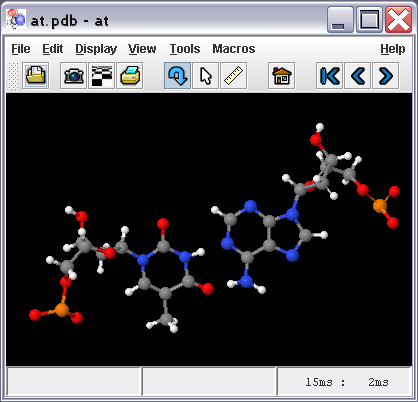Difference between revisions of "Jmol Application"
AngelHerraez (talk | contribs) (→Advanced options) |
AngelHerraez (talk | contribs) (→Command line options) |
||
| Line 20: | Line 20: | ||
=== Command line options === | === Command line options === | ||
| + | |||
| + | ==== Basic options ==== | ||
| + | These are described in the [http://jmol.sourceforge.net/docs/JmolUserGuide/ch02.html application documentation]. Briefly: | ||
| + | * Load a molecular file: | ||
| + | ''fileName'' | ||
| + | * Show help: | ||
| + | -h or --help | ||
| + | * Run a script: | ||
| + | -s or --script ''whatever script file'' | ||
| + | * Set the window size (by default, the last size used or else 500x500): | ||
| + | -g or --geometry ''width x height'' | ||
| + | * Set the language to be used for the interface (default English) [http://wiki.jmol.org/index.php/User:AngelHerraez#Forcing_Jmol_to_open_in_a_certain_language see also]: | ||
| + | -Duser.language=de|en|es|fr|nl|pl | ||
| + | * Report the display speed in either frames per second or milliseconds per frame (the default): | ||
| + | -Ddisplay.speed=fps|ms | ||
| + | * Sets a path where to look for plugins for Jmol: | ||
| + | -Dplugin.dir=''/path/to/plugins'' | ||
| + | * Sets memory use (see below): | ||
| + | -Xmx''size'' | ||
==== Giving Jmol more memory to work with ==== | ==== Giving Jmol more memory to work with ==== | ||
Revision as of 19:58, 25 September 2006
Contents
Jmol Application
"Jmol Application" is the version of Jmol that runs as a standalone program, in its own window. It uses the Java programming language.
Control of the molecular model is gained through several means:
- The mouse (documented in Mouse Manual).
- The application's menu and toolbar (at the top of the window), which offer
- File open, export, and print functionalities.
- A limited set of selection and rendering options, and several tools.
- The pop-up menu (or context menu, opened by right-click or Ctrl+click on the model's panel), which offers most funcionality available and is identical to applet menu.
- The scripting language (same used by the applet); this is available through the File > Script... menu, which opens a "script console" or command-line environment.
Starting Jmol Application
Several ways:
- Double-click on
 Jmol.jar file.
Jmol.jar file. - Click on a previously created shortcut (Windows terminology) (HowTo).
- Click on a previously created Start menu entry (Windows terminology) (HowTo).
- Execute one of the batch files/shell scripts that are part of Jmol distribution (Windows, MacOS, Linux, Unix).
- From the command line:
java -jar Jmol.jar(of course, issued from the folder/directory where Jmol.jar is, or else pointing to it with a full path). See memory options below. - Double-click on a molecular coordinates file whose extension has been previously associated to Jmol (HowTo).
Command line options
Basic options
These are described in the application documentation. Briefly:
- Load a molecular file:
fileName
- Show help:
-h or --help
- Run a script:
-s or --script whatever script file
- Set the window size (by default, the last size used or else 500x500):
-g or --geometry width x height
- Set the language to be used for the interface (default English) see also:
-Duser.language=de|en|es|fr|nl|pl
- Report the display speed in either frames per second or milliseconds per frame (the default):
-Ddisplay.speed=fps|ms
- Sets a path where to look for plugins for Jmol:
-Dplugin.dir=/path/to/plugins
- Sets memory use (see below):
-Xmxsize
Giving Jmol more memory to work with
Memory available to Jmol is determined by Java. Less or more memory can be allocated by using:
java -Xmx###m -jar Jmol.jar
where the ### must be substituted by a number in megabytes (hence the "m" after it).
Technically:
- -Xmx sets the maximum memory heap size.
- -Xms sets the minimum memory heap size.
Batch files and shell scripts included with Jmol 10.2 distribution are written to give -Xmx512m (512 Mb maximum).
Advanced options (Jmol v.11)
Create a JVXL file directly:
Jmol -ionx iso.spt myfile.xyz > myfile.jvxl
where:
- -i,--silent silent startup operation
- -o,--noconsole no console -- all output to sysout
- -n,--nodisplay no display (much faster)
- -x,--exit run script and exit
and iso.spt is:
isosurface solvent;show isosurface
creates a JVXL solvent surface file.
Create a list of measurements:
Jmol -ionx measure.spt myfile.xyz > measure.txt
where measure.spt is:
measure allconnected (*) (*);show measurements
generates a list of measurements.
measure.txt now contains (tab-separated):
Measurement Information
distance 1.1217928 0.112 nm H 1 #1 C 10 #10
distance 1.4158994 0.142 nm N 2 #2 C 6 #6
distance 1.3865448 0.139 nm N 2 #2 C 7 #7
...
Check CIF file symmetry:
Jmol -ionx symmetry.spt myfile.cif > symmetry.txt
where symmetry.spt is:
show unitcell;show symmetry;show spacegroup;
Anything that can be "shown" can be dumped to a file this way. And anything you can get from getProperty will do the same.
Contributors
AngelHerraez, EricMartz, Pimpim, Cudo29, NicolasVervelle, Green
